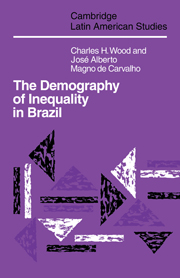Book contents
- Frontmatter
- Contents
- Illustrations
- List of tables
- Preface
- 1 Introduction
- 2 Framework for the study of population, development and inequality
- 3 Growth and distribution in historical perspective
- 4 Income inequality and length of life
- 5 Wage policy, infant mortality and collective social action in São Paulo
- 6 Racial inequality and child mortality
- 7 The “baby bust”
- 8 Income distribution and population growth
- 9 Agrarian structure and the rural exodus
- 10 Colonization and frontier expansion in Amazônia
- 11 Development and persistent underemployment
- 12 The demography of inequality in Brazil: summary and conclusion
- Appendix: A note on method
- Notes
- Bibliography
- Index
- CAMBRIDGE LATIN AMERICAN STUDIES
11 - Development and persistent underemployment
Published online by Cambridge University Press: 04 August 2010
- Frontmatter
- Contents
- Illustrations
- List of tables
- Preface
- 1 Introduction
- 2 Framework for the study of population, development and inequality
- 3 Growth and distribution in historical perspective
- 4 Income inequality and length of life
- 5 Wage policy, infant mortality and collective social action in São Paulo
- 6 Racial inequality and child mortality
- 7 The “baby bust”
- 8 Income distribution and population growth
- 9 Agrarian structure and the rural exodus
- 10 Colonization and frontier expansion in Amazônia
- 11 Development and persistent underemployment
- 12 The demography of inequality in Brazil: summary and conclusion
- Appendix: A note on method
- Notes
- Bibliography
- Index
- CAMBRIDGE LATIN AMERICAN STUDIES
Summary
An unchallenged doctrine in the development literature during the 1950s and 1960s held that successful economic progress could be realized only through the twin forces of capital accumulation and industrial growth. The conclusion was supported by empirical generalizations of the Western European and North American experiences, described in terms of the continuous transfer of people from low productivity rural agricultural activities to urban-based productive industrial employment. The model pictured a long procession advancing slowly over a difficult terrain, each traveler following the footsteps of preceding ones. “Led by the old, now fully industrialized countries with Japan following close on their heels, that caravan is stretched out in the diminishing order of their per capita national income figures, the poorest straggling several centuries behind” (Leontief 1983: 407).
In W. Arthur Lewis's (1954) two-sector model, development occurs via the transfer of labor from the traditional rural subsistence sector to the urban industrial one. Both the labor transfer and urban employment growth are brought about by output expansion in urban industries. Lewis assumed that, in the initial phase of development, the level of wages in the modern sector would be constant at a fixed rate that exceeds average rural income thereby inducing workers to migrate from their home areas to the city. The speed of modern sector employment creation is determined by the rate of capital accumulation and the reinvestment of these profits in expanded industrial production.
- Type
- Chapter
- Information
- The Demography of Inequality in Brazil , pp. 237 - 245Publisher: Cambridge University PressPrint publication year: 1988



